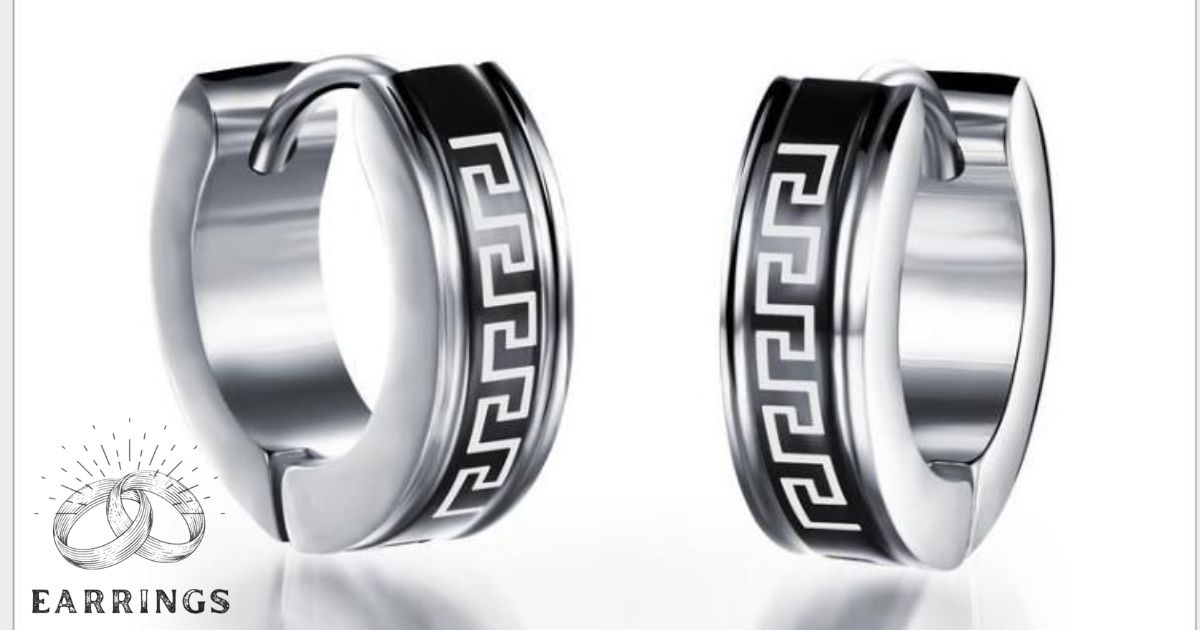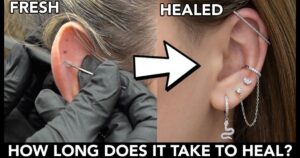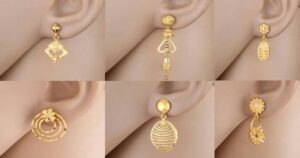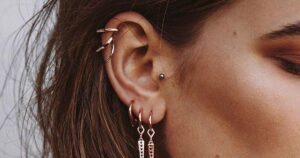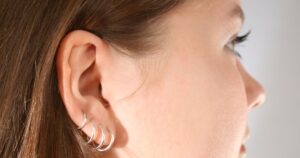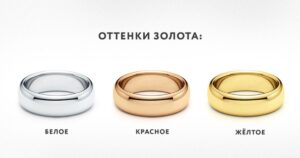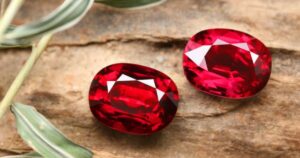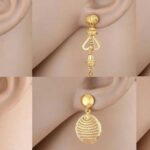Stainless steel earrings is an excellent choice for earrings due to its durability and corrosion resistance, making it resistant to tarnishing. It is hypoallergenic, making it suitable for individuals with sensitive skin. The sleek and modern appearance of stainless steel adds a timeless quality to earrings.
The enduring allure of stainless steel earrings, where style meets durability. Raise your accessory game with earrings that effortlessly combine fashion and function to ensure you shine without compromising on quality. Adding to the beauty of stainless steel is the perfect choice for those who want a lasting statement in their jewelry collection.
It is an alloy (alloy) of iron with at least 10.5% chromium. It is the chromium that prevents surface rust or corrosion. It also contains varying amounts of other elements such as nickel and molybdenum. Both chromium and nickel can cause skin allergies, but nickel is more often the problem.
What is stainless steel made of?
Stainless steel is an alloy which means it is a mixture of different metals. The primary components of stainless steel are iron, chromium, nickel, and carbon, along with other elements in smaller proportions. The exact composition can vary depending on the specific grade or type of stainless steel being produced.
The key elements in stainless steel are
Iron
The base metal that forms the majority of the alloy.
Chromium
Chromium forms a passive oxide layer on the surface that protects the steel from corrosion.
Nickel: Enhances the corrosion resistance of stainless steel and contributes to its strength and toughness.
Carbon
Strengthens the steel, but too much carbon can reduce corrosion resistance. Different grades of stainless steel have varying carbon content.
Other alloying elements
Various elements such as manganese, molybdenum, titanium and others may be added in specific proportions to achieve desired properties like increased strength, hardness or improved resistance to corrosion in specific environments.
The specific combination of these elements determines the properties and applications of different types of stainless steel. There are many different grades of stainless steel, each with its own unique characteristics suited for specific purposes, such as austenitic stainless steels, ferritic stainless steels, and martensitic stainless steels.
Does Stainless Steel Jewelry Tarnish?
Stainless steel jewelry is renowned for its durability and resistance to tarnishing. Unlike other metals, stainless steel contains chromium, which forms a protective layer on the surface, shielding it from corrosion and discoloration.
This inherent property makes stainless steel jewelry highly resistant to tarnish ensuring that it retains its lustrous appearance for an extended period. This resilience makes stainless steel an excellent choice for everyday accessories. It can withstand exposure to moisture, air and various environmental factors without losing its shine.
Its resistance to tarnishing stainless steel jewelry is hypoallergenic and low maintenance. This makes it a popular choice for individuals with sensitive skin or those seeking hassle free accessories. Its modern aesthetic and ability to maintain its polished look over time.
What stainless steel do we use in our jewelry at Carolily?
We prioritize quality and durability in our jewelry, and that’s why we exclusively use high grade stainless steel in our designs. Our stainless steel is carefully selected for its exceptional resistance to tarnishing and corrosion ensuring that your jewelry maintains its brilliance over time.
This premium material not only contributes to the longevity of our pieces but also reflects our commitment to providing you with accessories that stand the test of time. You can trust that the stainless steel used in Carolily jewelry not only meets our stringent quality standards but also offers a stylish and enduring addition to your collection.
What type of stainless steel is used in jewelry?
The most common type of stainless steel used is 316L stainless steel. This particular grade is favored for its excellent combination of durability, corrosion resistance and affordability. Often referred to as surgical or marine grade stainless steel, 316L contains chromium, nickel, and molybdenum.
The alloy’s ability to withstand exposure to everyday elements makes it ideal for crafting enduring and visually appealing jewelry pieces. With its hypoallergenic properties and resistance to corrosion, 316L stainless steel has become a popular choice for crafting high-quality and long-lasting jewelry that maintains its shine and integrity over time.
Does Stainless Steel Tarnish or Rust?
It is known for its resistance to tarnishing and rusting. Unlike other metals such as iron, stainless steel contains chromium which forms a protective layer on the surface when exposed to air and moisture. This layer called chromium oxide acts as a barrier that prevents corrosion and rust.
As a result, it maintains its sleek and shiny appearance over time making it a popular choice for various applications, from kitchen appliances to outdoor structures. Regular cleaning and maintenance can further enhance the longevity and aesthetics of stainless steel items ensuring they remain corrosion resistant and visually appealing.
How to Clean Stainless Steel Jewelry?
To clean stainless steel jewelry and keep it looking shiny, start by mixing a solution of mild dish soap and warm water in a bowl. Dip a soft cloth or a toothbrush into the soapy water and gently scrub the jewelry paying extra attention to crevices and any areas with dirt or grime. Rinse the jewelry thoroughly under warm running water to remove soap residue.
For added shine, you can polish the stainless steel with a microfiber cloth or a jewelry polishing cloth. Avoid using abrasive cleaners or brushes as they may scratch the surface of the stainless steel. Regular cleaning will help maintain the luster of your stainless steel jewelry and keep it looking new.
Best Stainless Steel Jewelry
Certainly! Here’s a table with 8 steps to guide you in choosing the best stainless steel jewelry:
| Step | Task | Description |
| 1 | Define Your Style | Determine your preferred style – classic, modern, edgy, or minimalist – to narrow down options. |
| 2 | Quality Grade Check | Opt for jewelry labeled as 316L or 304 stainless steel, known for durability and corrosion resistance. |
| 3 | Hypoallergenic Assurance | Ensure the jewelry is hypoallergenic to prevent skin irritations and reactions. |
| 4 | Surface Finish Evaluation | Examine the surface finish for high polish or brushed textures based on your style preference. |
| 5 | Design and Detail Examination | Assess intricate details, craftsmanship, and design elements to ensure they meet your expectations. |
| 6 | Weight and Comfort | Consider the weight and comfort of the jewelry, especially for items worn daily or for extended periods. |
| 7 | Clasp and Closure Inspection | Check the quality of clasps and closures to ensure they are secure and durable. |
| 8 | Brand Reputation and Reviews | Research the brand’s reputation and read customer reviews to gauge the overall satisfaction with their stainless steel jewelry. |
Do You Need Hypoallergenic Earrings?
Hypoallergenic earrings have become increasingly popular as individuals seek jewelry options that are gentle on sensitive skin. Unlike conventional earrings made from materials like nickel or other base metals, hypoallergenic earrings are crafted from materials less likely to cause allergic reactions. For those looking to experiment with their accessories, a creative and unconventional option is to use an earring as a nose stud.
This innovative approach allows individuals to showcase their style by repurposing earrings for a unique and personalized touch. Hypoallergenic materials ensure that even this unconventional use is gentle on sensitive skin, making it a versatile and trendy choice for those with allergies or sensitivities.
It’s crucial to note that even individuals without known allergies can benefit from choosing hypoallergenic earrings to prevent the development of sensitivities over time. As the demand for allergy-friendly accessories continues to rise, jewelry designers and manufacturers are incorporating innovative materials and techniques.
What Are the Safest Earrings for Your Ears?
Selecting the safest earrings for your ears involves considering various factors to ensure both comfort and well-being. Hypoallergenic materials such as titanium, surgical stainless steel and 14-karat or higher gold are excellent choices. They are less likely to cause allergic reactions. Nickel-free options are crucial as nickel allergies are common and can lead to irritation.
Earrings with smooth, rounded edges minimize the risk of snagging or scratching the delicate skin around the earlobe. It is advisable to choose earrings with secure and properly fitting backs to prevent accidental loss. Seeking earrings labeled as nickel-free, hypoallergenic or sensitive skin can guide you toward options specifically designed for individuals with sensitivities.
Regular cleaning of earrings and earlobes along with avoiding prolonged wearing of heavy earrings, can further promote ear health and prevent discomfort. Overall, prioritizing high quality materials and thoughtful design ensures the safest and most comfortable experience for your ears.
How To Clean Your Stainless Steel Jewelry?
Cleaning stainless steel jewelry requires care to maintain its luster and appearance. Here are five unique methods you can use:
Baking Soda Paste
- Create a paste by mixing baking soda with water until it forms a thick consistency.
- Apply the paste to the stainless steel jewelry using a soft cloth or a toothbrush.
- Gently scrub the jewelry, paying attention to crevices and intricate details.
- Rinse thoroughly with water and dry with a clean, soft cloth.
Vinegar and Olive Oil Combo
- Mix equal parts white vinegar and olive oil in a bowl.
- Dip a soft cloth into the mixture and rub it onto the stainless steel jewelry in circular motions.
- The vinegar helps remove any tarnish, while the olive oil adds a shine.
- Wipe off excess with a clean cloth, ensuring a streak-free finish.
Club Soda Soak
- Pour some club soda into a bowl or a cup.
- Submerge the stainless steel jewelry in the club soda for a few hours or overnight.
- Remove the jewelry, rinse it thoroughly with water, and pat dry with a clean cloth.
- This method helps break down and remove accumulated grime.
Toothpaste Polish
- Use a non-gel toothpaste with mild abrasives (avoid using baking soda-based toothpaste).
- Apply a small amount of toothpaste to the jewelry and gently rub with a soft toothbrush or cloth.
- Work the toothpaste into the jewelry, paying attention to any areas with tarnish.
- Rinse off the toothpaste thoroughly with water and dry the jewelry.
- Cornstarch and Water Slurry
- Create a slurry by mixing cornstarch with water to form a paste.
- Apply the cornstarch paste to the jewelry and let it sit for 10-15 minutes.
- Gently rub the paste around the jewelry, focusing on any areas that need extra cleaning.
- Rinse the jewelry with water and dry it with a soft cloth.
Remember to test any cleaning method on a small, inconspicuous area of your stainless steel jewelry first to ensure it doesn’t cause any damage. Always follow the care instructions provided by the manufacturer, if available.
FAQ’s
Is stainless steel good for earrings?
Stainless steel is an excellent choice for earrings because it’s hypoallergenic, resistant to tarnish, and durable, ensuring long-lasting wear without irritation.
Why choose stainless steel earrings?
Stainless steel earrings are corrosion-resistant, making them ideal for daily wear, and their affordability adds a practical touch to stylish and resilient accessories.
Are stainless steel earrings suitable for sensitive ears?
Yes, stainless steel is hypoallergenic, making it a safe option for those with sensitive ears, as it minimizes the risk of irritation or allergic reactions.
Do stainless steel earrings tarnish or rust?
No, stainless steel earrings are resistant to tarnish and rust, maintaining their polished appearance over time, even when exposed to moisture or air.
Can I shower or swim with stainless steel earrings?
Stainless steel earrings are water-resistant, making them suitable for showering or swimming, as they won’t corrode or lose their shine in contact with water.
Conclusion
In conclusion, stainless steel emerges as an excellent choice for earrings. It offers a blend of durability, hygiene, and aesthetic appeal. Its corrosion resistant properties make it resistant to tarnish and discoloration ensuring a long lasting and low maintenance option for jewelry. Stainless steel is hypoallergenic making it suitable for those with sensitive skin or metal allergies.
This quality is particularly crucial for earrings as they come in direct contact with the skin.The material’s versatility allows for a wide range of designs from classic to contemporary, providing individuals with diverse options to complement their personal style. All in all stainless steel earrings stand out as a reliable and stylish choice combining practicality with enduring beauty.
